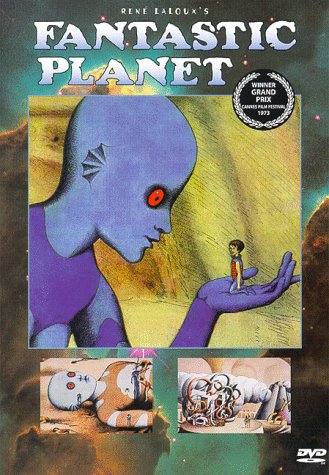
FANTASTIC PLANET (LA PLANETE SAUVAGE)
Czechoslovakia/France, 1973, 75 minutes, Colour.
Directed by Rene Laloux.
The Fantastic Planet is a faraway planet, where giants are in charge. Their subjects are tiny human types who must fight for life and equality. The film is not merely science fiction but also uses imagination and explorations of more metaphysical questions. There are two species on the planet, the Traags who are spiritual beings as well as giants; the other species are Oms, some of whom are domesticated, like toys or slaves, the others are wild, living outside civilisation. The focus of the action is on one of the Oms who escapes and uses the headphones of the Traags in order to improve himself. However, he meets up with the rebels and there is a battle.
The film is visually interesting and challenging, somewhat influenced by the psychedelia of the late 1960s. It also incorporates some religious themes and rituals. The Fantastic Planet is an unusual film – especially emerging from Czechoslovakia during the communist regime in the early 1970s.
1. The interest of this film, appeal, quality?
2. The styles of animation for the themes, the shapes, colour, movement, editing, voices and music? What kind of world was communicated by the animation?
3. The appeal of science fiction, science fantasy? interpretation of the past and present? forebodings for a future? The fable aspects of science fiction?
4. The Czech memories of this story? Czech co-production and style, appeal? To the European audience? Non-Europeans? How relevant were the themes to Europe rather than to the rest of the world? Why not?
5. Critics said that the contents and the themes were very ordinary for Science Fiction. Was this true? Does it matter? How important is it to explore ordinary themes well? Did this film explore them well, or trivially?
6. The film's basic message about society, individuals, creativity, revolution, survival, the need for harmony?
7. The visual presentation of the planet, landscapes, colours, comparisons with the world we know? What atmosphere and emotions did it evoke? For audiences to identify, be alienated? The consequences for the characters who lived there?
8. The visual impact of the inhabitants of the planet: that they lived in the realm of thought and spirituality? The contrast with the Oms and humanoid characteristics? The Oms being the physical side of nature, their breeding, subjugated state? The DrapRs? and the less physical side? Superiority? Their complementary behaviour to exterminate the Oms? The conflict situation and the way it was visualised?
9. Tiwan and Terr as symbols of the two groups? Their appearance, activities? The biblical overtones of the story and the revelation of the Chosen People? Tiwan and her Father? Place in space? Education, the mistake of Terr being educated? His exile, being with the wild Oms, raising them to consciousness of their state? The inevitability of a revolution?
10. The film's presentation of learning leading to an awareness, to revolution? The Oms stealing and killing? The retaliatory policy?
11. The theme of revolution, counter revolution and extermination? The importance of the detail of visualisation of war and destruction?
12. The optimism and hope of Terr and his knowledge, building the rocket, escaping, a brave new world?
13. The revelation of the fantastic planet, its purpose, the Dragg’s control, the strange creatures and the animation? faceless? The Oms and their destruction of the Dragg empire?
14. On what was the final harmony built? Could it last?
15. How valuable is this kind of film for social comment?